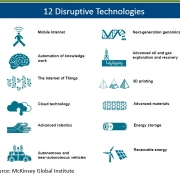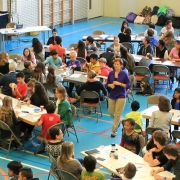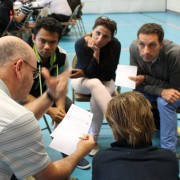This post, originally from January 2013, highlights one of the key frameworks in the M&B toolbox. We use the features of complex adaptive systems to create tools, methods, and frameworks that allow us to be more agile and realize greater results than we ever thought possible. We leverage these assets and resources to create a new and more desirable future for our clients and partners.
The metaphor of the machine or clockwork universe continues to dominate the way we think and talk about the world.
This unusually persistent meme can be traced to Isaac Newton and Copernicus, who understood the universe in terms of elegant, linear, predictable relationships. Behavior in this world is easy to predict, and therefore easy to control.
The theory is that one can understand anything – from the human body to the universe – by dissecting it and completely describing each part. And some things work this way, like your car engine or your computer.
However, we now know that many aspects of our world defy this kind of analysis, that the universe is a system of many systems that operate by a completely different set of rules. The weather, markets, communities, organizations, ecologies of organisms and our own brains, are systems that cannot be reduced to the sum of their parts.
They are complex adaptive systems that learn as they develop. And although the parts interact in unpredictable ways, they develop rich patterns of complex order through a process of feedback that further influences their development. Over time, these systems become more complex, more coherent and more organized.
Here are some components of complex adaptive systems:
Self-organization: Complex adaptive systems are not planned by a central controller. It is the activity of agents in the system, acting individually and collectively that leads to emergent order. Like birds flocking and fish shoaling according to simple rules of interaction
Systems within systems: Within each complex adaptive system are other smaller systems that interact with each other. Some of the most complex systems humans have created, such as the stock market, food production and distribution, transport systems and the Internet interact with humans in an evolving symbiotic relationship.
Emergence: There is no command, control, planning or managing. It is the activity of all of the parts of the system which influences the activity of the other parts of the system.
Feedback loops: Through feedback, connections grow in a system, which gathers momentum, and patterns start to form, leading to the development of more complex patterns.
Simple rules: A few simple rules of interaction lead to complex outcomes. For example, a shift in the way we speak to each other – from “you must!” to “what if we?” – builds trust and accelerates communication that leads to highly synchronized teamwork.
Period doubling cascade: Complex adaptive systems periodically undergo “phase transitions” to a higher level of organization, in what is known as a “period doubling cascade”. For example, the stages of development of the human brain, the magical moment when a group becomes a high performing team and the big social and technological shifts that occur when humans invent smarter tools, such as the shift from the typewriter to the computer.
Coevolution: When the environment changes, individual parts of the environment adapt to the new conditions created by the interaction of all of the parts.
Dynamic stability: Complex adaptive systems live dynamically on the edge of chaos, where new possibilities emerge from the variety and creativity of the system. These give it life and sustain it.
This is a very different world to the clockwork or networked universe with which we are familiar, one that is much more dynamic, less predictable–and, ultimately more malleable–than the one that has shaped so many of our institutions and organizations.
“Control is….an emergent property, not an option to be selected.” – Dr. David S. Alberts, US Defense









Leave a Reply
Want to join the discussion?Feel free to contribute!